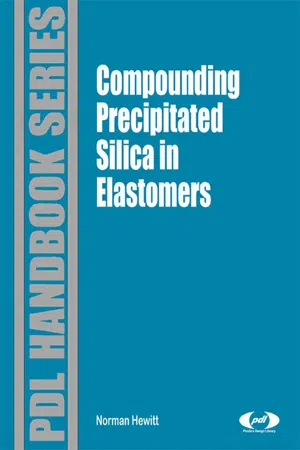1.1 INTRODUCTION
The subject of this chapter is fine particle, precipitated, hydrated silica and its use as a reinforcing filler for elastomer compounds. A more complete definition, relative to its position in the family of silicas, relies on a classification of commercial silicon dioxide, based on origin and primary particle size. Table 1.1 is a partial listing of the many varieties used in rubber compounding under the word “silica”.
Table 1.1 Forms and Properties of Silica Used in Rubber Compounding
| | Primary Size, μm | Function in Rubber |
| Natural (crystalline): | | |
| Ground quartz | 1-10 | Extending |
| Diatomite | 1-5 | Processing; Extending |
| Neuberg silica | 1-5 | Extending |
| Synthetic (amorphous): | | |
| Fumed | 0.005-0.02 | Reinforcing |
| Precipitated | 0.01-0.03 | Reinforcing |
| Precipitated | 0.04 | Semi-reinforcing |
| Precipitated | 0.08 | Processing; Color |
| Ferro-silicon by-product | 0.10 | Extending |
The two major classes, based on origin, are natural and synthetic. This distinction translates to a division between crystalline and amorphous forms, and, of equal importance, to a substantial division between coarse and fine primary particles.
Among the natural, non-reinforcing materials, the term “ground quartz” includes a number of variously named grades which are defined in respect to their geographic and geologic origin. For example, the grade known as “tripoli” is quartz mined mainly in southern Illinois, USA. The adaptability of this material to fine grinding has led to an erroneous classification as an amorphous type. Neuberg silica, better known as Sillitin™, derives from a German deposit of corpuscular quartz and kaolin. Quartz fillers find their principal use as extenders in silicone compounds, and elsewhere, to provide transparency.
Among the synthetic group, rubber reinforcement, in terms of enhanced abrasion resistance and tear and tensile strengths, is supplied only by those precipitated and fumed silicas with primary particle diameters below 40 nanometers (0.040 microns). The larger particle size grades (above 40 nanometers) are noted for their contribution to nerve reduction and smooth, extruded surfaces during compound processing operations.
The largest particle material, used only as an extender, is a furnace type, sometimes called microsilica. It is formed as a by-product during the manufacture of ferro-silicon alloy or silicon metal.
Fumed or pyrogenic silicas offer the smallest particle sizes and, therefore, the highest degree of reinforcement. They are produced by the high temperature hydrolysis of silicon tetrachloride, a process which results in a pure silica with low silanol and water content. Processing problems and high prices have limited fumed silica markets to silicone compounds and other specialty elastomers.
The ensuing compounding discussions and formula recommendations in Chapters 2 to 7 are centered on the reinforcing grades of precipitated silicas in the 15 to 20 nanometer size range.
1.2 MANUFACTURE OF PRECIPITATED SILICA
Precipitated silica is produced by the controlled neutralization of dilute sodium silicate (waterglass) by either concentrated sulfuric, hydrochloric, or carbonic acids. The raw materials are those required for the silicate: sand, soda ash, caustic soda, and water. The silicate can be produced in furnace or digester operations, but in either case the ratio of SiO2 to Na2O is generally within a range of 2.5 to 3.5. Dilution with water provides relatively low silicate concentrations, which, together with moderate acidification rates, produce a precipitate of particulates rather than gel agglomerates. A minor amount of gel is usually present. Reaction temperature is the major determinant of primary particle size.
Precipitation produces a low solids content slurry of hydrated silica and residual salts, either sodium sulfate, sodium chloride or sodium carbonate. The salts are removed by washing in either a counter-current decantation system or by filter press. Washing reduces the salt content to 1 or 2%. Further concentration in rotary or plate and frame filters produces a solid wet cake which still contains only 15 to 25% silica. Because of this high water content, the final drying step, whether by rotary, tray, belt or spray dryers, is a large consumer of energy. Due to lower investment and operating costs, spray drying has become the dominant drying process. In all cases the final product still contains about 6% free water, which is roughly the equilibrium free water content at 50% relative humidity. The end product is often milled and compacted to attain an optimum balance between the absence of visible particles and minimal dustiness during rubber mixing.
Precipitation, if carried out with too rapid addition of concentrated acids, produces a small amount of silica gel. Gel content generally has no adverse effect on reinforcement, but it can be a significant source of undispersed, visible particles in the mixed elastomer compound. Visible dispersion is discussed further in Section 1.6.
Silica manufacturing stages can be related to rubber processing and compound properties. Reinforcement potential depends entirely on primary particle size, which is fixed during the early stages of neutralization. Precipitation parameters involved in setting particle size include temperature, silicate ratio, reaction rate, reactant concentrations, and the presence of additives. Precipitation temperature correlates with size; low temperatures produce small particles. Slow rates of neutralization reduce gel formation. Silicate and acid concentrations also relate to gel formation; high concentrations produce more gel. These relationships are summarized in Table 1.2.
Table 1.2 Manufacture and Compounding
| Silica operation | Behavior in rubber |
| Precipitation | Reinforcement |
| Precipitation; drying; milling; compaction | Visible dispersion |
| Drying; milling; compaction | Dustiness |
